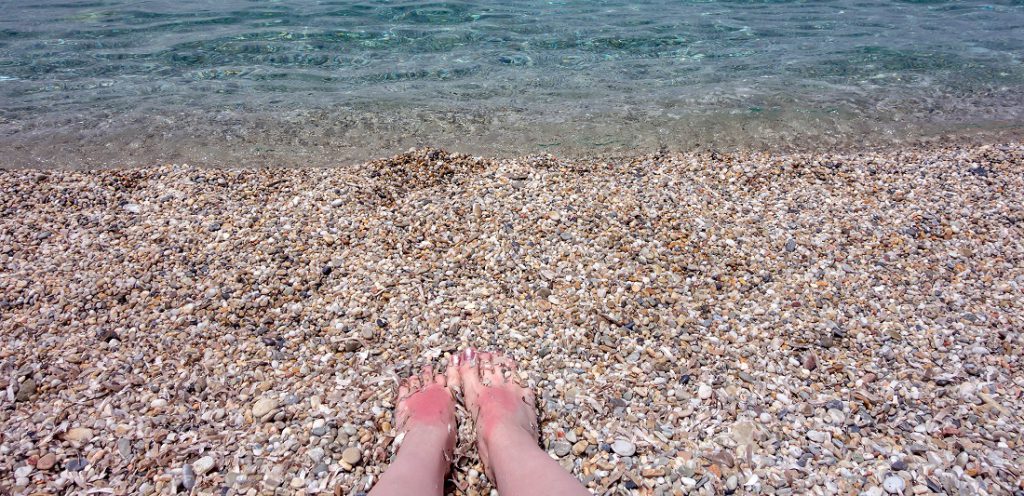Imagine this: You just enjoyed a fun, sunny day outside with friends. Before you left home, you diligently applied your sunscreen all over your face and body, and you reapplied throughout the day. But when you get home, you notice a blazing red spot on your ear. Despite your best efforts, you missed a spot! Sound familiar?
The truth is that this is pretty common when it comes to sunscreen application — while we’re focused on protecting our bigger body parts, we often forget about the little ones. Those minor sunburns add up, contributing to your skin cancer risk.
An isolated burn is unlikely to increase your risk of skin cancer. However, the same spots may consistently get burned during recreational exposure. “There is compelling evidence that repeated sunburns, especially when suffered in childhood, portend a significant increase in risk for some of the worse cancers of the skin,” says Adolfo Fernandez-Obregon, MD, a board-certified dermatologist practicing in New Jersey and a spokesperson for The Skin Cancer Foundation. On average, a person’s risk for melanoma doubles if he or she has had more than five sunburns in a lifetime.
Below, Dr. Fernandez-Obregon discusses the areas we often forget to protect that become skin cancer hot spots later in life. We’ve also provided some friendly tips for making sure you safeguard these areas in the future.
Your scalp and hairline. Have you ever sunburned a bald spot or the part in your hair? It hurts! As we age and hair thins, this becomes more apparent in men and women alike. “This process of gradual hair thinning exposes the scalp that has not been exposed to sun previously, and that results in a proportionally larger representation of skin cancers,” he says. When applying sunscreen on your face and neck be sure to go all the way up to your hairline. If you don’t want to put sunscreen on your hair part or bare scalp, then cover up with a wide-brimmed hat. If you like straw hats, look for one with a tight weave that doesn’t allow light to penetrate.
Your ears. We often forget to slather them with sunscreen while tending to the rest of the face. The consequence? About 7 percent of head and neck melanomas are found on the ears. Dr. Fernandez-Obregon theorizes that our ears are often exposed when we’re in cars. (Although windshields are treated to block UV rays, car door windows typically aren’t.) Additionally, people drive with the windows down more during the summer months. It’s important to apply sunscreen to the entire ear, top to bottom, including the inside crevice. A wide-brimmed hat will protect your ears too.
Your feet. You might think feet never see the light of day, but if you’re outside barefoot or in open-toed shoes, think again. “Skin cancers found on the feet are rare but possible and surprisingly occur more often in people of color,” says Dr. Fernandez-Obregon. Acral lentiginous melanoma (ALM), an especially dangerous form of melanoma that typically appears on the palms of the hands and soles of the feet, is more prominent in people with dark skin tones, although experts aren’t sure why. If you’re wearing flip-flops, sandals or going barefoot, be sure to apply sunscreen to the tops and bottoms of your feet, making sure not to skip in between your toes.
Your lips. Your lips are exposed to the sun, just like the rest of your skin. Skin cancer on the lip is most likely to occur in fair-skinned males over age 50. “Men are more likely to work outside for long periods of time throughout their life span, making them more susceptible to this type of damage,” says Dr. Fernandez-Obgreon. Most lip cancers occur on the bottom lip, which receives more sun exposure than the top. In fact, actinic cheilitis, a precancerous lip inflammation caused by long-term sun exposure, is approximately 12 times more likely to affect the bottom lip than the top. To protect your lips, use a lip balm with sunscreen ingredients and remember to reapply at least every two hours, just like regular sunscreen. Remember to reapply after eating or drinking, too. Shiny lip balms and gloss without an SPF designation actually attract the sun, which can lead to painful burns and skin damage.
Your hands and fingernails. OK, you’ve applied sunscreen to your arms, but did you go all the way down to your fingertips? Just like the feet, the tops of our hands are vulnerable to sunburns and skin cancers, and they are one of the first areas of the body to show signs of aging. “Skin aging and consistent sun exposure accentuate veins, and lead to freckles and sun spots. Actinic keratoses can also start to develop which are now considered early forms of squamous cell carcinoma,” he says. While not very common, you can even develop skin cancer under your fingernails, which typically shows up as a dark spot under the nail bed. Whenever you wash your hands, apply a hand cream with sunscreen ingredients before going outside. It will keep your skin moisturized and protected.
Your eyes and eyelids. Approximately 5 to 10 percent of all skin cancers occur on the eyelid or the eye itself. “These skin cancers typically crop up along the outer rim of the lids and respond well to surgical removal because they tend to be spotted early,” says Dr. Fernandez-Obregon. According to a 2017 study, the most commonly missed areas during sunscreen application on the face are the eyelids and the area between the inner corner of the eye and the bridge of the nose. Because the skin on the eyelid is so thin, he recommends using a mineral sunscreen on this area to avoid irritation. Apply sunscreen over the lids, up to the brow bone and under the bottom lids, being extra careful not to get any in your eye. And whenever you’re outside, protect your eyes with UV-blocking sunglasses.
There you go! With your new, more mindful approach to sun protection, you can enjoy time outdoors knowing you’re fully protected, from head to toe.




